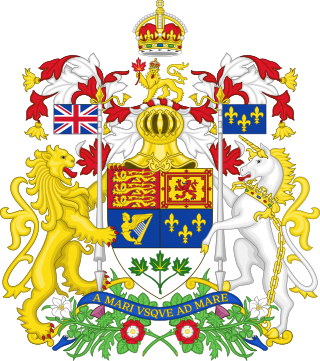
The 1867 Canadian federal election was held from August 7 to September 20, 1867, and was the first election for the new country of Canada. It was held to elect members representing electoral districts in the provinces of Nova Scotia, New Brunswick, Ontario and Quebec to the House of Commons of the 1st Canadian Parliament. The provinces of Manitoba (1870) and British Columbia (1871) were created during the term of the 1st Parliament of Canada and were not part of this election.

The 14th Canadian Parliament was in session from 8 March 1922 until 5 September 1925. The membership was set by the 1921 federal election on 6 December 1921, and it changed only somewhat due to resignations and by-elections until, due to momentary confusion among the MPs, it lost a money vote and was dissolved, causing the 1925 election.

The 15th Canadian Parliament was in session from 7 January 1926, until 2 July 1926. The membership was set by the 1925 federal election on 29 October 1925, and it changed only somewhat due to resignations and by-elections until it was dissolved prior to the 1926 election.
By-elections to the 17th Canadian Parliament were held to elect members of the House of Commons of Canada between the 1930 federal election and the 1935 federal election. The Conservative Party of Canada led a majority government for the 17th Canadian Parliament.
By-elections to the 16th Canadian Parliament were held to elect members of the House of Commons of Canada between the 1926 federal election and the 1930 federal election. The Liberal Party of Canada led a minority government for the 16th Canadian Parliament.
By-elections to the 15th Canadian Parliament were held to elect members of the House of Commons of Canada between the 1925 federal election and the 1926 federal election. Initially the Liberal Party of Canada and the Progressive Party of Canada formed a coalition government for the 15th Canadian Parliament, following the King–Byng Affair the Conservative Party of Canada was given a minority government, which dissolved quickly.
By-elections to the 14th Canadian Parliament were held to elect members of the House of Commons of Canada between the 1921 federal election and the 1925 federal election. The Liberal Party of Canada led the government, which fluctuated between a minority and majority, for the 14th Canadian Parliament.
By-elections to the 13th Canadian Parliament were held to elect members of the House of Commons of Canada between the 1917 federal election and the 1921 federal election. Prime Minister Robert Borden, then Arthur Meighen, led a majority government consisting members collectively known as the Unionist Party, during the 13th Canadian Parliament.
By-elections to the 11th Canadian Parliament were held to elect members of the House of Commons of Canada between the 1908 federal election and the 1911 federal election. The Liberal Party of Canada led a majority government for the 11th Canadian Parliament.
By-elections to the 10th Canadian Parliament were held to elect members of the House of Commons of Canada between the 1904 federal election and the 1908 federal election. The Liberal Party of Canada led a majority government for the 10th Canadian Parliament.
By-elections to the 9th Canadian Parliament were held to elect members of the House of Commons of Canada between the 1900 federal election and the 1904 federal election. The Liberal Party of Canada led a majority government for the 9th Canadian Parliament.
By-elections to the 8th Canadian Parliament were held to elect members of the House of Commons of Canada between the 1896 federal election and the 1900 federal election. The Liberal Party of Canada led a majority government for the 8th Canadian Parliament.
By-elections to the 7th Canadian Parliament were held to elect members of the House of Commons of Canada between the 1891 federal election and the 1896 federal election. The Conservative Party of Canada led a majority government for the 7th Canadian Parliament.
By-elections to the 6th Canadian Parliament were held to elect members of the House of Commons of Canada between the 1887 federal election and the 1891 federal election. The Conservative Party of Canada led a majority government for the 6th Canadian Parliament.
By-elections to the 5th Canadian Parliament were held to elect members of the House of Commons of Canada between the 1882 federal election and the 1887 federal election. The Conservative Party of Canada led a majority government for the 5th Canadian Parliament.
By-elections to the 4th Canadian Parliament were held to elect members of the House of Commons of Canada between the 1878 federal election and the 1882 federal election. The Conservative Party of Canada led a majority government for the 4th Canadian Parliament.

By-elections to the 3rd Canadian Parliament were held to elect members of the House of Commons of Canada between the 1874 federal election and the 1878 federal election. The Liberal Party of Canada led a majority government for the 3rd Canadian Parliament.
By-elections to the 2nd Canadian Parliament were held to elect members of the House of Commons of Canada between the 1872 federal election and the 1874 federal election. The Conservative Party of Canada led a majority government for most of the 2nd Canadian Parliament.
By-elections to the 1st Canadian Parliament were held to elect members of the House of Commons of Canada between the 1867 federal election and the 1872 federal election. The Conservative Party of Canada led a majority government for the 1st Canadian Parliament.

René Arseneault is a Canadian politician who was elected to represent the riding of Madawaska—Restigouche in the House of Commons of Canada in the 2015 federal election, and was re-elected in the 2019 and 2021 federal elections.